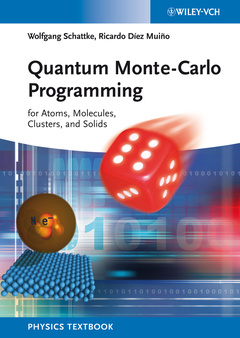Description
Quantum Monte-Carlo Programming
For Atoms, Molecules, Clusters, and Solids
Authors: Schattke Wolfgang, Díez Muiño Ricardo
Language: English
Subject for Quantum Monte-Carlo Programming:
Approximative price 76.75 €
In Print (Delivery period: 12 days).
Add to cart
Publication date: 09-2013
296 p. · 17x24 cm · Paperback
296 p. · 17x24 cm · Paperback
Description
/li>Contents
/li>Biography
/li>
In one source, this textbook provides quick and comprehensive access to quantitative calculations in materials science. The authors address both newcomers as well as researchers who would like to become familiar with QMC in order to apply to their research. As such, they cover the basic theory required for applying the method, and describe how to transfer this knowledge into calculation. The book includes a series of problems of increasing difficulty with associated stand–alone programs which will be available for free download.
1 A First Monte–Carlo Example 2 Variational Quantum–Monte–Carlo for a One–Electron System 3 Two Electrons with Two Adiabatically Decoupled Nuclei: Hydrogen Molecule 4 Three Electrons: Lithium Atom 5 Many–Electron Confined Systems: Quantum Dot 6 Many–Electron Atomic Aggregates: Lithium Cluster 7 Infinite Number of Electrons: Lithium Solid 8 Diffusion Quantum Monte–Carlo (DQMC) Appendices A The Interacting Classical Gas B Two Electrons with Two Adiabatically Decoupled Nuclei: Hydrogen Molecule C Three Electrons: Lithium Atom D Many–Electron Periodic Systems: Lithium Solid References
Wolfgang Schattke is a retired member of the Institut für Theoretische Physik und Astrophysik der Christian-Albrechts-University Kiel where his teaching covered the branch of theoretical physics from the basic courses to advanced topics of the PhD curriculum. His research interests focus on material properties of the solid state and its surfaces investigated with ab-initio electronic structure methods. Besides studying numerical access to photoemission spectroscopy, his scientific efforts point to many-body theory where Quantum Monte-Carlo offers a central tool to complete the successful application of Density Functional Theory to material sciences.
Ricardo Díez Muino is Vice Director of the Centro de Física de Materiales, a Joint Center between the University of the Basque Country UPV/EHU and the Spanish Research Council CSIC in San Sebastian. Previously, he developed his research activity in the Donostia International Physics Center DIPC (Spain), the Lawrence Berkeley National Laboratory (USA), and the Université de Bordeaux (France). His main field of research is condensed matter theory, particularly electronic excitations in metallic systems, with some excursions into atomic and molecular physics.
Ricardo Díez Muino is Vice Director of the Centro de Física de Materiales, a Joint Center between the University of the Basque Country UPV/EHU and the Spanish Research Council CSIC in San Sebastian. Previously, he developed his research activity in the Donostia International Physics Center DIPC (Spain), the Lawrence Berkeley National Laboratory (USA), and the Université de Bordeaux (France). His main field of research is condensed matter theory, particularly electronic excitations in metallic systems, with some excursions into atomic and molecular physics.
© 2024 LAVOISIER S.A.S.




